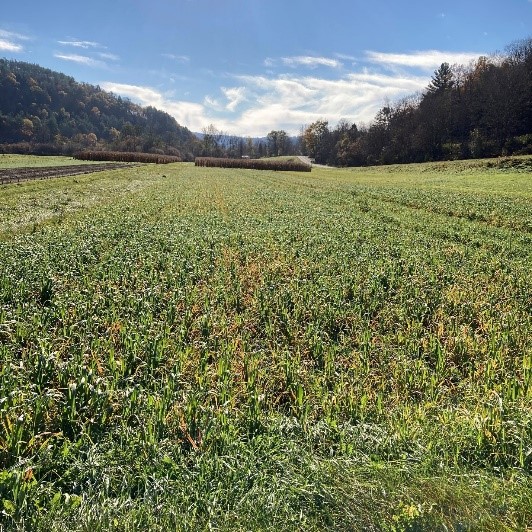By Sonia Howlett, VT Agency of Agriculture, Food & Markets
Did you know that cover crops have been grown for millennia? The use of off-season crops that helped to replenish the soil has been documented across many agricultural societies, including in ancient China, the Indus River valley, and early Rome. Cover crops were widely used in early colonial America as well, but their use decreased in United States in the 1940s and 1950s when commercial fertilizer became readily available, and the long-term effects of soil erosion and fertilizer overuse was not widely known or considered.
In recent decades, collective understanding of the interconnectedness of agriculture, water quality and soil heath has improved in America and many annual crop farmers have turned (back) to cover crops to help keep/build topsoil on their fields. Cover crops increase organic matter in soil, reduce soil erosion, and can increase water infiltration. In addition, although only legume cover crops directly fix nitrogen in the soil, research suggests that even non-legume cover crops might play a role in helping prevent nitrogen leaching during wet winters by taking up and storing excess soil nitrogen until the spring.
If you are interested in growing cover crops, but not sure where to start, your local NRCS, UVM Extension or Conservation District can help you decide what makes sense for your farm. There are many kinds of plants that you can grow as cover crops, depending on your goals. Some die over the winter so you don’t have to terminate them in the spring, others fix nitrogen, others will yield you an early spring hay cut… but all will help build your soil.
If you plant cover crops this fall, the Vermont Agency of Agriculture, Food and Markets can help you cover the cost of seed. The Farm Agronomic Practices (FAP) program provides $45/acre to support cover crops that are drilled or incorporated, or $30/acre to support cover crops that are broadcast or interseeded.
FAP applications which include cover crop are due August 1, 2022.
Other eligible practices for the FAP program include manure injection ($25/acre), crop to hay planting ($35/acre, or $45/acre with a nurse crop such as oats or peas), no till annual crop planting ($15/acre), and no-till hay and pasture renovation ($20/acre). Applications for these other practices are due 30 days prior to installation.
When you apply, please include all practices planned until June 30, 2023, and remember that we cannot fund the same practice on the same field that will be paid for by any other state or federal grant programs.
For more information on the FAP program requirements and to apply go to agriculture.vermont.gov/fap. If you have specific questions about practice eligibility, or how the FAP program works, you can contact Nina Gage at Nina.Gage@vermont.gov or 802-622-4098 or Sonia Howlett at Sonia.Howlett@vermont.gov or 802-522-4655.

Caption: Cover crops on a vegetable farm in the Connecticut River Valley. Sometimes called “green manure” because of their beneficial effect on crops, cover crops have been used across the globe for thousands of years to reduce soil erosion and improve soil health.

